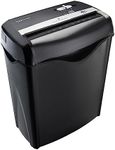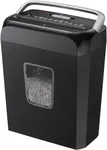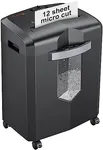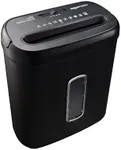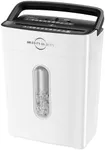Buying Guide for the Best Paper Shredders For Home Use
Choosing the right paper shredder for home use involves understanding your specific needs and the features that different models offer. Paper shredders are essential for protecting your personal information and ensuring that sensitive documents are disposed of securely. When selecting a shredder, consider factors such as the type of cut, capacity, and additional features that can enhance convenience and security.Cut TypeThe cut type refers to how the shredder slices the paper. There are three main types: strip-cut, cross-cut, and micro-cut. Strip-cut shredders cut paper into long strips and are the least secure, suitable for non-sensitive documents. Cross-cut shredders cut paper into small pieces, offering a higher level of security and are ideal for most home use. Micro-cut shredders provide the highest security by cutting paper into tiny particles, perfect for highly sensitive documents. Choose based on the level of security you need.
Sheet CapacitySheet capacity indicates how many sheets of paper the shredder can handle at once. This is important for efficiency and convenience. Low-capacity shredders can handle 5-10 sheets at a time and are suitable for occasional use. Medium-capacity shredders can handle 10-20 sheets and are good for regular home use. High-capacity shredders can handle more than 20 sheets and are ideal if you frequently need to shred large volumes of paper. Consider how often and how much you need to shred to determine the right capacity for you.
Bin SizeThe bin size refers to the volume of shredded paper the shredder can hold before it needs to be emptied. Smaller bins (up to 3 gallons) are suitable for light use and small spaces. Medium bins (3-5 gallons) are good for regular home use, while larger bins (over 5 gallons) are ideal for heavy use and less frequent emptying. Think about how often you want to empty the bin and the amount of shredding you do to choose the appropriate size.
Run Time and Cool Down TimeRun time is how long the shredder can operate continuously before needing to cool down. Cool down time is the period the shredder needs to rest before it can be used again. Short run times (2-5 minutes) are suitable for occasional use. Medium run times (5-10 minutes) are good for regular home use. Long run times (10+ minutes) are ideal for heavy use. Consider how much shredding you do in one session to choose a shredder with an appropriate run time and cool down time.
Noise LevelNoise level refers to how loud the shredder is during operation. Quieter models are preferable for home use, especially if you will be shredding frequently or in shared spaces. Noise levels are usually measured in decibels (dB). Shredders with lower dB ratings (below 60 dB) are quieter and more suitable for home environments. Consider your tolerance for noise and the location where you will use the shredder to choose the right noise level.
Safety FeaturesSafety features are important to prevent accidents and ensure safe operation. Look for features like automatic shut-off, safety locks, and sensors that detect hands near the shredder opening. These features are especially important if you have children or pets at home. Choose a shredder with adequate safety features to ensure safe use in your household.
Additional FeaturesAdditional features can enhance the convenience and functionality of your shredder. Features like jam protection, auto-feed, and credit card shredding capabilities can be useful. Jam protection helps prevent paper jams, auto-feed allows for continuous shredding without manual feeding, and credit card shredding ensures secure disposal of plastic cards. Consider which additional features would be beneficial for your specific needs.
